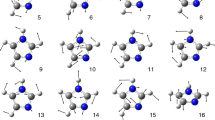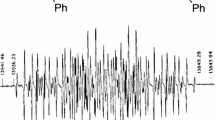Abstract
Room temperature Mössbauer spectra of tris(N,N′-dialkyldithiocarbamato)iron(III) complexes [(R2NCS2)3Fe] (R = Me, Et, n-Pr, i-Pr, n-Bu and i-Bu) exhibit an asymmetric doublet which can be resolved into two doublets, each corresponding to high and low spin states in equilibrium. The quadrupole splitting (ΔE Q ), in general, increases with the molecular weight of the alkyl group in both the cases. Plots of magnetic moment (μeff) versus temperature show that dimethyl-, diethyl-, di-n-propyl- and di-n-butyl-substituted dithiocarbamato complexes are equilibrium mixtures of high and low spin states at room temperature, but increasingly adopt low spin at the liquid nitrogen temperature. However, the di-i-propyl- and di-i-butyl-substituted dithiocarbamato complexes exhibit primarily low spin state in the 77–350 K range, with a small contribution (<15%) of high spin state. Fe—S stretching vibrations in far i.r. region also show spin equilibrium states. Thermogravimetric studies show fast decomposition in the 200–300 °C range, yielding Fe(SCN)3 as an intermediate product followed by slow decomposition, leading finally to constant weight corresponding to Fe2O3 at ca. 650 °C. Mössbauer spectra of the final products of all the complexes exhibit a six line spectrum with H eff = 517 ± 3 kOe corresponding to that of α-Fe2O3 without any possibility of Fe2S3 as proposed in literature.
Similar content being viewed by others
References
R.L. Dutta and A. Syamal, Elements of Magnetochemistry, 2nd edit., Affliated East-West Press Pvt. Ltd., New Delhi, 1993, p. 157.
P. Gutlich in G.J. Long (Ed.), Mössbauer Spectroscopy Applied to Inorganic Chemistry, Plenum Press, New York, 1984, Vol. 1, p. 287.
P. Gutlich in R.H. Herber (Ed.), Chemical Mössbauer Spectro scopy, Plenum Press, New York and London, 1984, p. 27.
J.O. Hill and R.J. Magee, Rev. Inorg. Chem., 3, 141 (1981).
G.D. Thorn and R.A. Ludwig, The Dithiocarbamates and Related Compounds, Elsevier, New York, 1962.
R. Rickards, C.E. Johnson and H.A.O. Hill, J. Chem. Phys., 48, 5231 (1968).
A.H. Ewald, R.L. Martin, E. Sinn and A.H. White, Inorg. Chem., 8, 1837 (1969).
G.R. Hall and D.N. Hendrickson, Inorg. Chem., 15, 607 (1976).
B. Hutchinson, P. Neill, A. Finkelstein and J. Takemoto, Inorg. Chem., 20, 2000 (1981).
J.M. Fiddy, I. Hall, F. Grandjean, U. Russo and G.J. Long, Inorg. Chem., 26, 4138 (1987).
I. Morishima and T. Jizaka, J. Am. Chem. Soc., 96, 5279 (1974).
P.B. Merrithew and P.G. Rasmussen, Inorg. Chem., 11, 325 (1972).
R.B. Lanjewar and A.N. Garg, Polyhedron, 12, 2619 (1993).
M. Kopf, D. Varech, J. Tuchagues, D. Mansuy and I. Artaud, J. Chem. Soc., Dalton Trans., 991 (1998).
Z.J. Zhong, J. Tao, Z. Yu, C. Dun, Y. Liu and X. You, J. Chem. Soc., Dalton Trans., 327 (1998).
B.S. Manhas and S. Bala, Polyhedron, 24, 2465 (1988).
A.H. Ewald, R.L. Martin, I.G. Russo and A.H. White, Proc. Royal Soc., A280, 235 (1964).
J. Willemse, J.A. Cras, J.J. Stegerda and C.D. Keijers, Struct. Bonding, 28, 83 (1976).
R.J. Butcher, J.R. Ferraro and E. Sinn, Inorg. Chem., 15, 2077 (1976).
M. Sorai, J. Inorg. Nucl. Chem., 40, 1031 (1978).
D.C. Bradley and M.H. Gitlitz, J. Chem. Soc. A, 1152 (1969).
F. Bonati and R. Ugo, J. Organometal. Chem., 10, 257 (1967).
K. Nakanishi and P.H. Solomon, Infrared Absorption Spectroscopy, 2nd edit., Holden Day Inc., San Francisco, 1977, p. 50.
P. Gutlich, R. Link and A. Trautwein, Mössbauer Spectroscopy and Transition Metal Chemistry, Springer-Verlag, Berlin, 1978, p. 56.
A.K. Sharma, Thermochim. Acta, 104, 339 (1986).
G. D'Ascenzo and W.W. Wendlendt, J. Inorg. Nucl. Chem., 32, 2431 (1970).
R.B. Lanjewar and A.N. Garg, Ind. J. Chem., 31A, 849 (1992).
W. Kundig, H. Bommel, G. Constabaris and R.H. Lindquist, Phys. Rev., 142, 327 (1965).
Author information
Authors and Affiliations
Rights and permissions
About this article
Cite this article
Singhal, S., Sharma, C.L., Garg, A.N. et al. Magnetic moment and Mössbauer spectral studies of spin-crossover in tris(N,N′-dialkyldithiocarbamato)iron(III) complexes and their thermal decomposition. Transition Metal Chemistry 26, 81–88 (2001). https://doi.org/10.1023/A:1007115823823
Issue Date:
DOI: https://doi.org/10.1023/A:1007115823823




